Special symposium with the staff
of The Last Guardian Part 3
Fumito Ueda×Masanobu Tanaka
(Interviewer) Masami Tanji

Special symposium with the staff
of The Last Guardian Part 3
Fumito Ueda×Masanobu Tanaka
(Interviewer) Masami Tanji
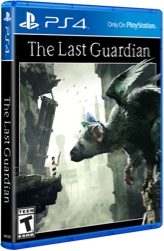
Title
The Last Guardian
Release Date
Out Now
Genre
Adventure / Action
Platform
PlayStation®4
PS4®Pro ENHANCED
For HD TV Enhanced games, players can benefit from
increased image clarity, faster frame rates, or more.
Value
Disk version $19.99
Downloading version $19.99
ESRB Ratings
T

Publisher : SIEA
Developer:Sony Interactive Entertainment World Wide Studios JAPAN Studio
We got a lot of questions through social media. Thank you! We got more than expected and we won’t be able to answer all of them but we will try to answer as many as possible.
Just like last time, this conversation also contains spoilers.
So read at your own risk or come back after you've finished the game!
(Bold text: Masami Tanji)
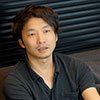

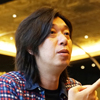
This studio was formed by bringing together lead staff involved in the development of Ico and Shadow of the Colossus, beginning with Fumito Ueda. Under his guidance, it was responsible for the entire creative aspect of The Last Guardian.
All of the creative direction, including game design, animation, level design, modeling, etc., was completed by a small number of elite staff.
To continue digging deep into the story, just like with ICO and Shadow of the Colossus, the story became really impressive because players were left with lingering memories despite the fact that dialogue was intentionally largely left out. I’m going to jump right to the ending – there seemed to be a lot of complications and changes before the ending was decided on.
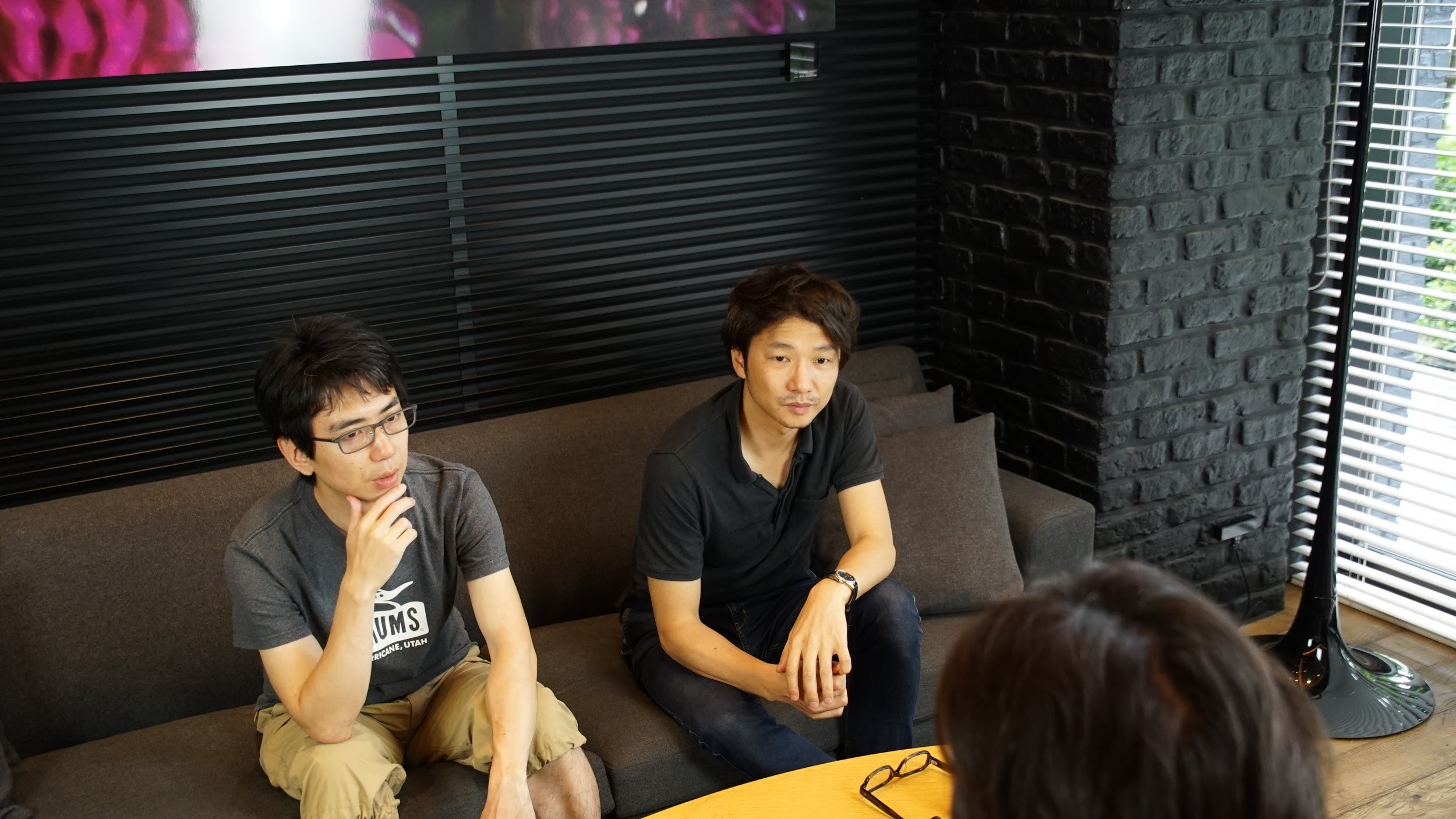
Ueda Yes, actually with the ending, we explored various options with regards to the development of the plot. For example, as it is an easy one to grasp, there is a “Trico does not return to the village version”, and a “Trico does return to the village” version. And, as you know, our decision was to explore the latter.
―You considered it for so long that it was really a last-minute addition to the storyboard, right? I tried remembering it again, but since I know the manuscript for the final version, I couldn’t really recall the version where Trico does not return to the village.
Ueda Trico and the boy are flying over the cliffs surrounding the eagle’s nest and Trico tries to put the boy on the cliff but at the last minute he is hindered again by the hostile eagles. Trico falls from the cliff and is lost. The other eagle cutting in when Trico is flying is a remnant of that plot. Then, the boy would walk alone on the cliff for a few weeks and eventually make his way back to the village.
―That ending is quite tough on the boy. (laughs) Being separated from Trico and making it home after weeks of walking……I’d like to see how that would resolve itself. Speaking of tough, the ending is also quite unfortunate for Trico. I remember there being a discussion about the appropriate display of cruelty levels during the production.
Ueda Was there? I don’t remember, could you give me an example?
―About the series of events where Trico is attacked by the other eagles on the tower and then attacked by the villagers upon his return to the village, there were talks such as “That’s quite harsh – can’t we hold back a bit more?” and “No, it’s natural for a group to want to protect themselves from danger, so it’s not unusually cruel.”
Ueda If you look at it from the villagers’ perspective, all they see is that they had their child kidnapped and an eagle fell from the sky and spat him out – so from that perspective their actions are properly motivated. It may seem cruel if you only look at it from one side… but the story changes completely depending on what you’re focusing on – that type of behaviour is common in the real world too. On the other hand, it was also a time where I was hooked on Game Of Thrones, so it may be that my sense of what constitutes an appropriate depiction of cruelty was distorted. (laughs)
※Game Of Thrones: an American fantasy drama television series aired on HBO. It often depicts very cruel and realistic events.
-You really were addicted to Game Of Thrones at the time (laughs). Cruelty is also prevalent in that show but it isn’t meaningless either, it just can appear that way based on the characters’ behaviour or their perspective. When the boy was abducted by the eagle, the village leader didn’t seem that sad, he looked like he had given up to some extent. If he truthfully didn’t want the kids to be kidnapped, then it seems a bit strange that he had them sleep all gathered together.
Ueda For the whole village, it might not have been thought of as something to be avoided – they thought of it as destiny. It was like being “The Chosen One”.
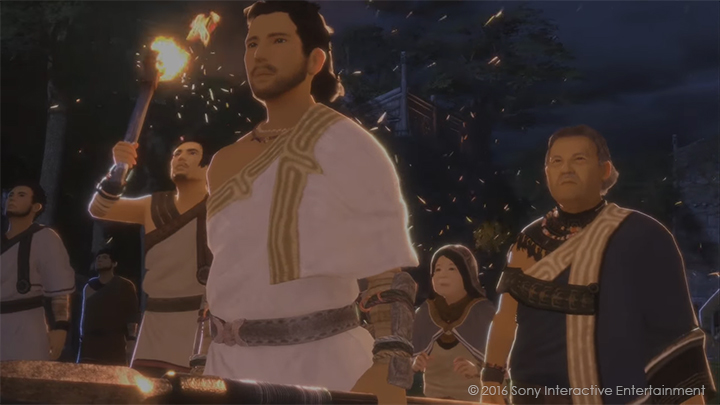
―I see. Trico sort of partially gave up and returned to the village, and the villagers were understandably surprised. I would also like to ask you about the flow of the ending after that point, but I also have a question about the “Final Instructions”, how did they come about?
Ueda I guess that has to do with the decision to use the gesture controls. For a variety of reasons the game changed little by little from a “game controlled by Trico” to a “game in which Trico is controlled”, so we included an interaction like that along the same vein.
―Those features where you have some control at the end were also present in ICO and Shadow of the Colossus, but the action in The Last Guardian almost seemed more emotionally charged.
Ueda As soon as I came up with the idea I sent it to the group chat used by the production team, and it surprisingly received really good feedback, so even though the schedule was tight we somehow managed to include it. “Giving instructions” was a very important element throughout this project, so it was very meaningful to be able to include instructions until the very last moment.
―There were also playable elements in the cutscene, which required a lot of preparation. The schedule really seemed tight (laughs), but you managed somehow.
Tanaka It was difficult to bring this game to a close, but in the final stages we cooperated with JAPAN Studio and thankfully we were able to get it in. I’m really glad that we managed.
※“JAPAN Studio: a studio within World Wide Studios (WWS) – a worldwide network of game development studios that makes games for the PlayStation®
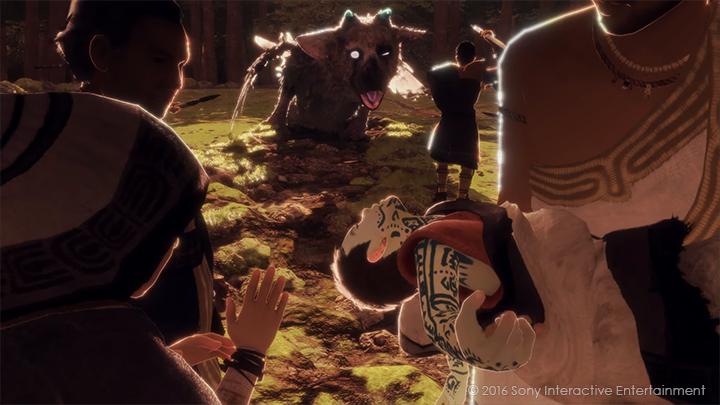
―I’m not really sure whether I can ask this question, but at the very end there is a scene where the boy, now a man, raises up the mirror and directs it towards the valley and the camera steadily flies off in that direction. That last scene… it was a bit hard to see, was there a reason for making it so dark?
Ueda
It’s a scene where Trico reacts to the signal from the mirror that the adult version of the boy raised up. Actually, originally the lighting was brighter in the last cut, but there was no time to really polish Trico’s movements, and we also thought that it would be better if it was left up to the player’s imagination. So at the last minute we decided to make it dark.
Incidentally, there was also an idea where Trico would run towards the camera upon feeling the signal that the adult version of the boy sent out, and the game would end that way.
「The most important thing when creating the script is to keep costs at a minimum」
―There seems to be many people who are interested in the story making process. Was there a set production method for creating the story?
Ueda Story development, like the ending plot for example, begins after the development and implementation of the game’s overall story and gameplay has stabilized to some extent. It was that way for ICO and Shadow of the Colossus as well.
―That’s pretty surprising to me. The game’s story isn’t decided at the beginning, but instead you wait until the game has been developed to a certain extent before you start thinking about the story?
Ueda
Yes. Of course, we’re thinking of a lot of rough plots, and we adjust the plot to fit the parameters of what we are able to realistically express. In regards to the process, we first write down a few rough plots, and build the most suitable expression and production we can with the tools and assets that are available to us at the time.
Gameplay is, of course, the number one priority. The image directing, such as cutscene development, is meant to compliment the gameplay, and thus must have a lower degree of priority. If the team resources are there it is nice to be able to do both concurrently…
Of course, I also want players to experience a good story, but that does not originate from the scenario at the beginning stage of the game creation.
―Priority on gameplay production – makes a lot of sense.
…Actually, this might be surprising, but Ueda-san, you’re relatively cost-conscious, right?
Ueda The most important thing when creating the script is to keep costs at a minimum. That’s an important element. Of course, it’s natural that the game should also look good.
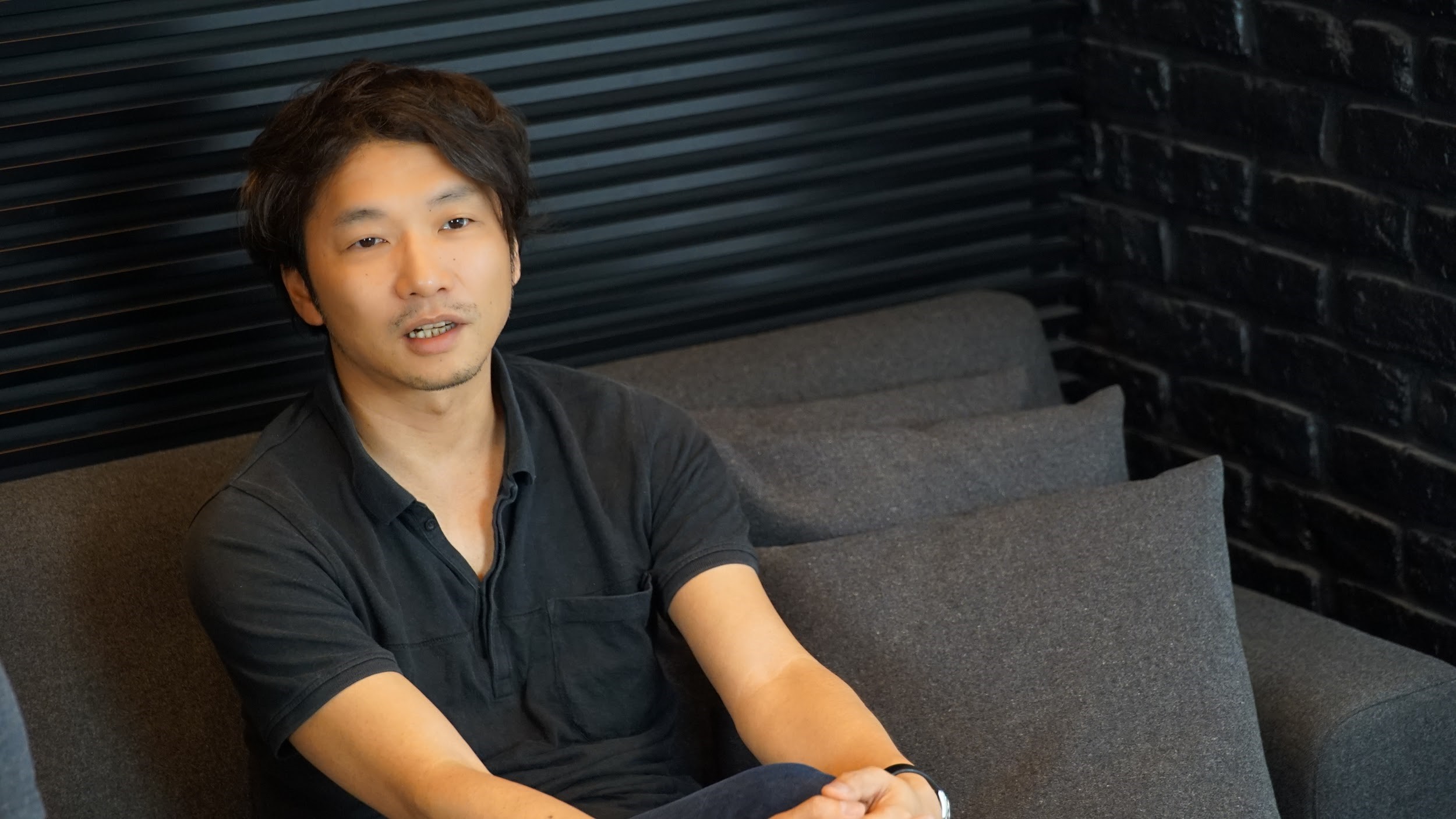
―It’s not simply a matter of cutting costs, right? Do you have any specific examples of reducing costs when producing The Last Guardian?
Ueda For example, the village first appears in a flashback, so it would make sense to reuse it. Then in that case, let’s use the village during the ending scene as well. Things like that. In any case, I always try to cut as many additional assets as possible while still making the cutscenes as emotional as possible.
―Players might not think that the story was created in that way, because it flows and connects so naturally. I also always thought that the story was finished before production started.
Ueda For example, out of all of the eagles that arrive on the top of the tower at the end, the only one whose movements are dictated by AI is the one closest to the boy. The movements of Trico in that scene are fixed and play on a repeated loop, so we changed the parameters of the AI processing used in Trico and put them into the enemy eagle nearest to the boy. That way the CPU load would not change.
―So it’s a way of cutting costs on the programming side – a cut for the processing load? I see, that’s interesting.
Ueda Of course, displaying a large number of eagles is a burden in itself… I draw up the storyboard while considering how to realize the image in my head at the same time… we plan in that way. When it’s just the storyboard you can talk big and broaden the scope of the game, so it’s always necessary to be paying attention to the cost. From there, further assets are prepared based on the storyboard, and real time rendering has to be done ......
―Even in cell animation, the storyboard has to be created while keeping in mind the boundaries of what can be expressed with cells, it’s similar to that.
Tanaka It’s hard to realize this from Ueda-san’s storyboard at first glance, but the same animation occurs many times but with slightly different appearances. For example, Trico’s animation when he is running and about to fly away and when he is threatening the villagers is slightly different, but the essential part of the movement is the same. Various movements can be expressed with various combinations of even the smallest amount of animation data. Moreover, the same animation appearing multiple times is useful for maintaining quality.
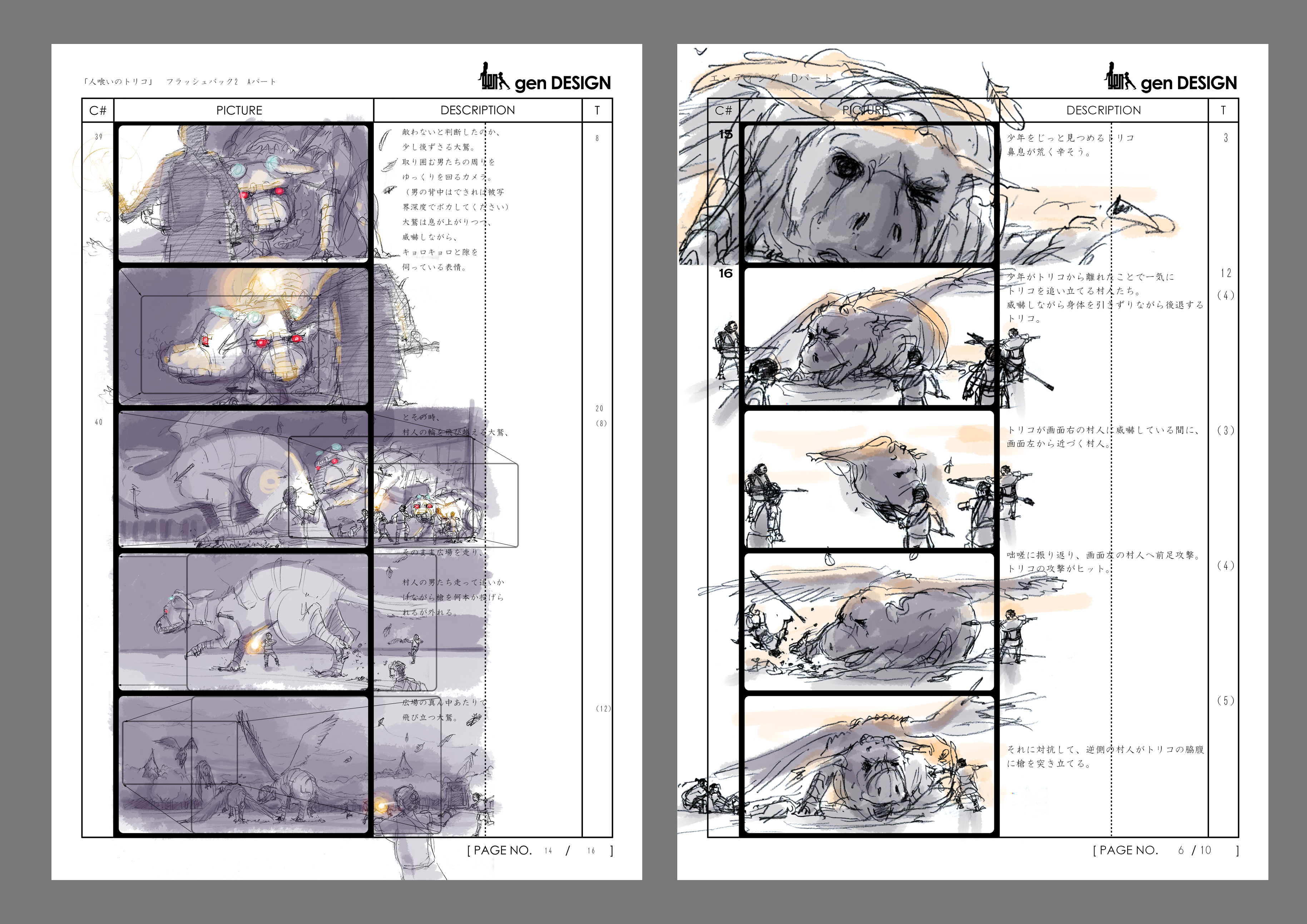
The flashback scene in which the boy is taken away, and the ending scene in which the two return. To cut costs the same animations were re-used for the villagers in the field
―Speaking of which, adding movement to a lot of mobs – the villagers – is costly, but you were able to do that as well.
Tanaka Well, making the movements of all of the villagers individually would certainly be difficult for a small studio. Therefore, the villagers’ movements were created as a controllable character in the game engine Unity. From there, we recorded how the characters moved and we outputed it as animation data.
*The Last Guardian was not created in Unity but in an original game engine made by JAPAN STUDIO.
―That was fun. Playing as the characters using a controller and recording their movements. It felt like the animation itself turned into a game. We all became characters. I wonder who from the staff was good at the controls.
Tanaka Besides that, for small animals we did things like reuse the animations Ueda-san had made in the ICO era. Assets such as bats that did not appear in ICO but have appeared continuously since Shadow of the Colossus.
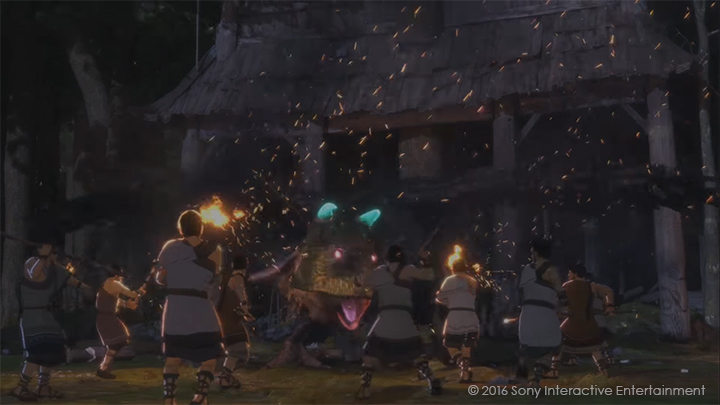
―In order to make a quality game that stays within the budget, it’s important to devise various work-arounds and use alternative solutions to problems rather than just confronting them. Are there any other things you are careful about when creating cutscenes?
Ueda Cutscene creation itself has fewer uncertainties when compared to the main part of the game, and even if there is trouble it is very rare to encounter a critical problem. There is a great sense of accomplishment in that sort of work itself, it’s difficult but it’s a lot of fun. However, we’re not making movies but games, so we have to always control ourselves and pay attention during development so that we don’t become complacent and get swallowed by the fascination and charm of creating cutscenes.
「There’s a legend where a stork carries a baby, right?」
―When the script for the cutscenes was being written there were lots of conversations with Ueda-san, but when polishing the story it seems that there were a lot of elements that were not particularly remarkable. For example, the name of the setting where the whole adventure takes place, for a long time it was called “The Eagle’s Nest” or “Valley of the Kings” but the name ended up as “Ukaiya”.
Ueda
That name comes from the valley of ukai (a traditional type of fishing in which a trained cormorant is used to catch fish) – Ukai Valley. I wanted the names and the world motif to be connected to “bird” (laughs).
Even though that name does not appear in the game I wanted to incorporate the name “Ukaiya” somehow, and finally we used the name for a medal you can get when you clear the game.
※Ukaiya Medal:An extra element you can receive when you clear The Last Guardian. Trico wears it around his neck.
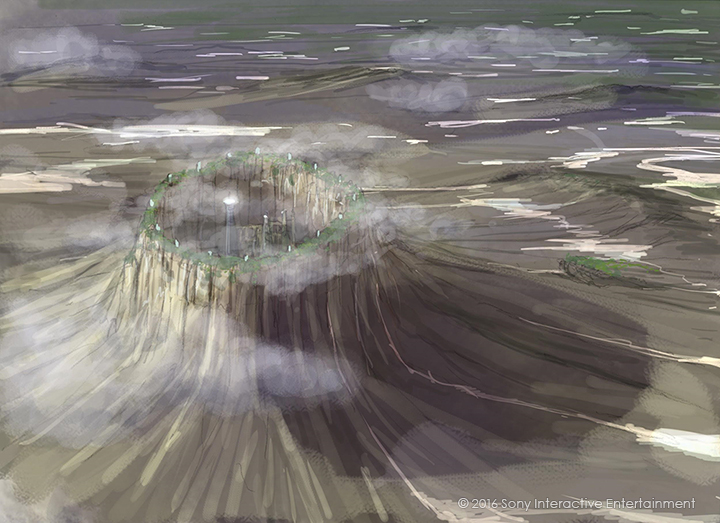
―“Ukai” is a way of catching fish using birds, that method of fishing seems perfect for the composition of the world of The last Guardian. You mentioned that you made a stork the motif for the whole game.
Ueda
Yes, there’s a legend where a stork carries a baby, right? I wondered if I could use that imagery.
The markings on the skin of the boy that Trico swallowed hint at that legend. After the ending of The Last Guardian and the legend of Trico is handed down to the next generation it would be nice if Trico was given a role similar to that of the stork.
―It’s not direct, but there are also traces of the stork motif in the name of the eagles: “Tricouno”. Originally, in this world, “Tricouno” was the word that represented that type of giant eagle…
Ueda Because the pronunciation is difficult for children we decided to call them Trico. Like how “lemonade” is called “ramune” in Japanese to make it easier for children to say. So the eagle that the boy befriends as well as all of the other eagles are all called Trico.
―Somehow calling your eagle companion “Trico” is a bit similar to calling a cat “cat!” or a dog “dog!”.
Ueda Yes, it’s something a child would do, so it’s cute.
―Other than that, there were some questions about the room with the coffin where the mirror was placed. That place is pretty important to the setting, isn’t it?
Ueda That’s right, there has to be a meaning in the setting. For example, that spring nearby might connect to somewhere else, things like that.
―There must also be a reason why the coffin is shaped the way it is, right?
Other than that, when you destroy the core of the tower and the enemy eagles violently fall down – there were a lot of people wondering why that happens. There was some talk about that sequence of events before, but I think it was a little difficult to understand?
Ueda Well… I figured that was enough to explain the situation. Basically, the core of the tower is the master and the eagles are the slaves and the eagles accept transmissions from the tower through their horns. But once the core of the tower – the place where all of the signals originated from – got broken, the enemy eagles started rampaging around. Trico, whose broken horns had been restored by that time, was also influenced by the destruction of the core, but his trust relationship with the boy won out over that influence.
―The horn of that eagle that was previously hostile towards Trico also broke off, so it survived in the end.
Ueda That’s right.
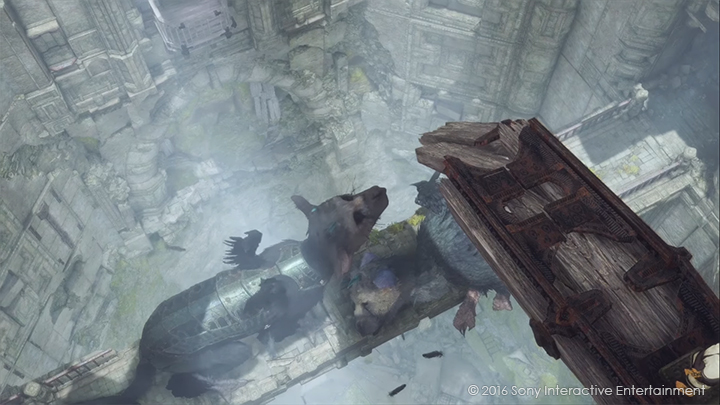
The scene where Trico fought the enemy eagle. When the railcar that the boy pushed hit the enemy eagle its horn broke along with its mask. This eagle also appeared at the end of the game.
―Speaking of that, during production, the cutscenes were made at genDESIGN, right? It’s a strength to be able to make a story which includes game design as well as interactive elements.
Tanaka Not just the ending, genDESIGN was in charge of various cut-scenes elements such as storyboard, animation production or lighting, and JAPAN Studio was in charge of setting up the scene, implementation, optimization on Playstation4, etc...and we cooperated closely together while developing.
Ueda Also, depending on the animation needs, genDESIGN would ask for help from another animation studio and Tanaka-san would supervise.
Tanaka Of course, we received help from the staff of JAPAN Studio, but I also started to make animation with X10Studio and gen, and I think we finished off with MARZA ANIMATION PLANET (hereinafter:MARZA) and BIGFOOT.
―I see, there were parts that you asked other companies to help with. What is the element that each studio was in charge of?
Tanaka
That’s right. MARZA was in charge of the impressive final scene where a lot of enemy eagles attack Trico. Thanks to that animation, everyone desperately wants to help Trico out (laughs).
BIGFOOT was also in charge of a scene on top of the tower, after the enemy eagle spits out a person and they’re all receiving a transmission while scrambling for the barrels. The enemy eagles’ ferocious side created an atmosphere of unease.
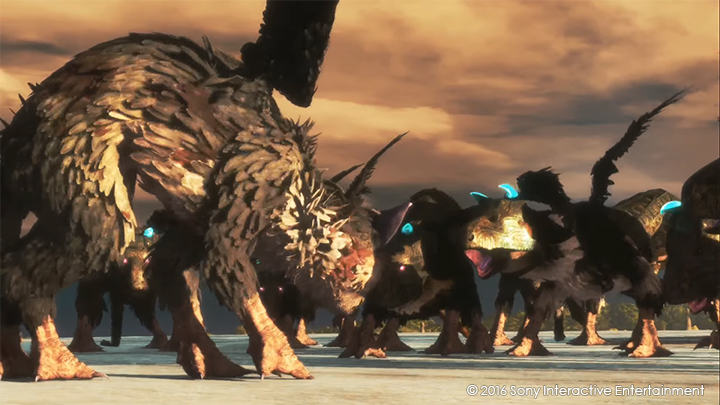
―I see, it’s an impressive scene that leads right into the ending. I’m sure you feel like they did a good job.
Speaking of which, the soundtrack wasn’t created in-house.
Ueda That’s right. Various things happened, so we decided to ask the composer Takeshi Furukawa.
―I’m interested in the “various things” that happened. When compared to ICO or Shadow of the Colossus, the music in The Last Guardian is more dramatic or emotional, was that the intention?
Ueda The music for ICO and Shadow of the Colossus was different from so-called game music. On top of that, we wanted to express restraint with regards to emotional expression as much as possible, that was the musical concept. While The Last Guardian inherited those elements, we incorporated Disney and Hollywood-like music in the hopes that we could appeal to a wider audience. Until now we had avoided using music in a mainstream way to clarify of the storyline, but looking back it feels as though we were embarrassed to adopt more conventional musical elements. In The Last Guardian we decided to go in that direction without feeling embarrassed.
―There was such a conflict?
Ueda I also wanted to make the music relatively traditional because of the existence of Trico himself, and because the setting and visuals already brought a lot of uniqueness to the story. On the other hand, cinematic music itself can easily be impressive, and if the music used in the game expresses strong emotion like in a movie, I feared that the player’s feelings might diverge from those conveyed in the music. I decided to ask Mr. Takeshi Furukawa, a composer who can make high-quality, more mainstream music that also has an element of restraint.
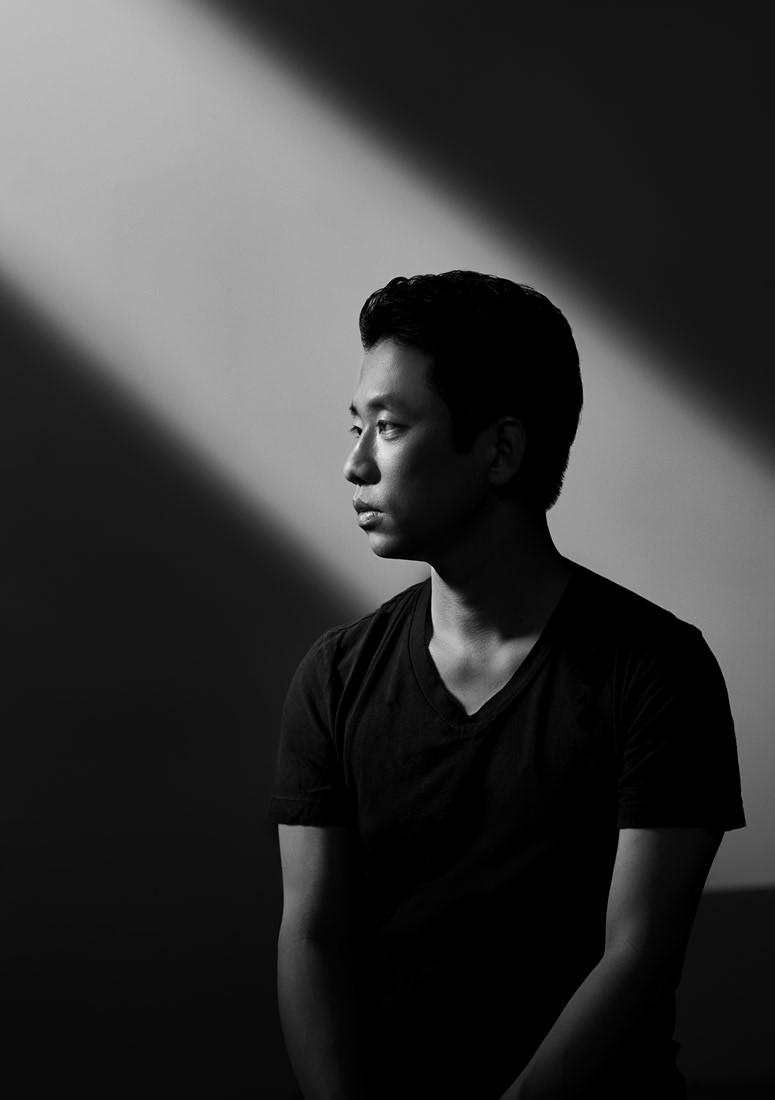
Takeshi Furukawa, head of music for “The Last Guardian”
―I see. So that’s how you came to decide on Takeshi Furukawa as the composer. I think the music was wonderful, and completely suited to The Last Guardian. Speaking of people outside of the company, I was quite surprised that Lisa Larson was asked to make a Trico figure.
*Lisa Larson:A world-wide famous culptor from Sweden. Main work includes "LION", "MIKEY" etc.
Ueda Yes. We decided to give it a try because we had nothing to lose. The timing was good so it was accepted, also due to JAPAN Studio’s hard work.
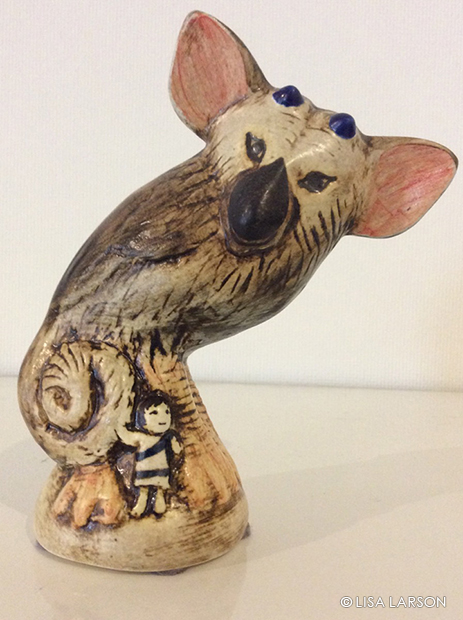
The Trico figure made by Lisa Larson
―Oh definitely, when I was first showed the prototype sent by Mrs. Lisa Larson, Trico’s ears were in the wrong spot – they didn’t match up with the real Trico. She fixed it, but I was still worried about how it would turn out (laughs). Why did you decide to make a figure in the first place?
Ueda Originally there were several talks about realistic figures… This might just be me, but even if I buy a figure I’m interested in, if I move or whenever I clean my house I end up throwing it away. For the Trico figure I’d feel bad if something like that happened.
―Ah, I think I understand. When you put the figure in the cart and press the pay button that’s the peak of excitement, but after it arrives you start thinking things like “why did I buy that?”
Ueda So, when I was thinking about things that I would still want to keep with me even when moving or cleaning my house, Mrs. Lisa Larson came to mind. We didn’t know how it would turn out, but a lot of people seemed to like it. That’s fortunate!
―It was surprising right? It was a treasure, everyone wanted it.
Ueda Well, yes that’s right (laughs).